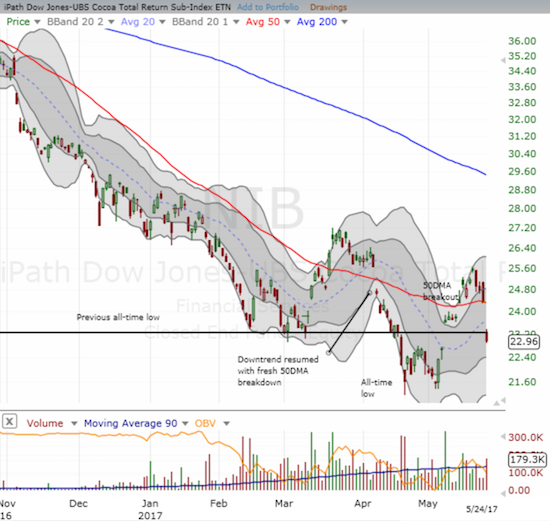The downtrend for the iPath Bloomberg Cocoa SubTR ETN (NIB) won out yet again.

Source: FreeStockCharts.com
The buyers looked particularly convincing for NIB’s latest 50DMA breakout. Yet, a 1-2 punch of a return of good weather results in Ivory Coast and a particularly aggressive crop production forecast from Rabobank killed the latest rally for NIB.
On May 22nd, Reuters reported good weather results for the Ivorian cocoa crop:
“Plentiful rain and sun last week in most regions of top cocoa grower Ivory Coast improved prospects for the April-to-September mid-crop, farmers said on Monday, although eastern regions continued to suffer the effects of a previous dry spell…
Farmers said good weather had led to abundant yields in the western regions of Duekoue and Gagnoa, the southern regions of Aboisso, Agboville and Divo and in the coastal region of Sassandra.
In the centre-western region of Daloa, which accounts for about a quarter of national output, farmers reported two heavy rainfalls and sun last week.”
The weather outlook suddenly looks so good that one farmer went as far to hope for an early start to the main crop season (October to March). This news stands in stark contrast to reports just two weeks ago of poor weather conditions in Ivory Coast. This back and forth reminded me why I do not make agricultural trades starting from assumptions or predictions of weather conditions! This weather news helped me understand NIB’s sharp reversal last Friday. The continued weakness in NIB should have alerted me to more trouble ahead.
In late November, 2016 Rabobank crowned cocoa as a top agricultural bet for 2017 (and panned coffee). At that time, NIB traded around $31 (35% higher than the current price). While Rabobank expected crop surpluses, its forecast seemed to rely on a pick-up in demand. Two months later, the bank lowered its price forecast but maintained cocoa as a top pick for 2017. Rabobank again cited a pick-up in demand (presumably stimulated by low prices). It explained the weakness since the time of its bullish call on weather and currency moves in the euro.
Fast forward another 4 months and Rabobank is singing a different tune. On May 24th, the bank issued a particularly bearish forecast for surpluses: 330,000 tons for 2016/2017 and 150,000 tons for 2017/2018. Compare this to the ICCO’s forecast for a 264,000 ton surplus. The only good news from Rabobank’s forecast is that it did not send NIB to a new all-time low. NIB gapped down from 50DMA support and closed with a whopping 5.6% loss.
While it is hard to imagine another analyst forecast that is yet even more bearish than Rabobank, I also concede that the downtrend in cocoa has proven its mettle. My last purchase of NIB should stand as my last one for a long while. In the meantime I am watching closely developments afoot to support the price of cocoa. The latest news on this front came from the African Development Bank (AfDB).
The AfDB laments how Africa exports so much unprocessed food and imports processed food. This imbalance exacerbates the booms and busts in the agricultural sector. For cocoa, Khaled Sherif, AfDB’s Vice-President for Regional Development, Integration and Business Delivery, recommended that major cocoa-growing countries invest in large storage facilities so that they can exert more control over the supply that goes out to market:
“The failure by the countries of the region to control the supply led to a price loss of US $1.2 billion, Sherif said. The losses could be curbed if the producers invested in warehousing and encouraged investors especially the world’s largest processors of cocoa to improve the value chain infrastructure.”
The AfDB is raising funds to support these investments and “…hopes to invest US $2.4 billion every year for 10 years to provide credit guarantees to farmers undertaking large agricultural sector investments.” In other words, investments now will have major payoffs in the future and particularly for the viability and sustainability of cocoa production as well as other African agricultural products.
Be careful out there!
Full disclosure: long NIB
